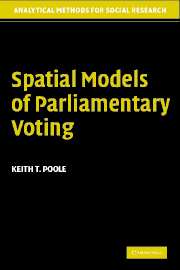Book contents
- Frontmatter
- Contents
- List of Tables and Figures
- Preface
- 1 Introduction
- 2 The Geometry of Parliamentary Roll Call Voting
- 3 The Optimal Classification Method
- 4 Probabilistic Spatial Models of Parliamentary Voting
- 5 Practical Issues in Computing Spatial Models of Parliamentary Voting
- 6 Conducting Natural Experiments with Roll Calls
- 7 Conclusion
- References
- Index
1 - Introduction
Published online by Cambridge University Press: 24 November 2009
- Frontmatter
- Contents
- List of Tables and Figures
- Preface
- 1 Introduction
- 2 The Geometry of Parliamentary Roll Call Voting
- 3 The Optimal Classification Method
- 4 Probabilistic Spatial Models of Parliamentary Voting
- 5 Practical Issues in Computing Spatial Models of Parliamentary Voting
- 6 Conducting Natural Experiments with Roll Calls
- 7 Conclusion
- References
- Index
Summary
Overview
In this book I show how to use a simple spatial model of voting as a tool to analyze parliamentary roll call data. Each legislator is represented by one point, and each roll call is represented by two points – one for Yea and one for Nay. On every roll call each legislator votes for the closer outcome point, at least probabilistically. These points form a spatial map that summarizes the roll calls. In this sense a spatial map is much like a road map. A spreadsheet that tabulates all the distances between pairs of sizable cities in the U.S. contains the same information as the corresponding map of the U.S., but the spreadsheet gives you no idea what the U.S. looks like. Much like a road map, a spatial map formed from roll calls gives us a way of visualizing the political world of a legislature. The closeness of two legislators on the map shows how similar their voting records are, and the distribution of legislators shows what the dimensions of the space are.
The number of dimensions needed to represent the points is usually small, because legislators typically decide how to vote on the basis of their positions on a small number of underlying evaluative, or basic, dimensions. For example, in recent U.S. Congresses, we can easily predict how a “liberal” or a “conservative” will vote on most issues. These basic dimensions structure the roll call votes and are captured by the spatial maps.
- Type
- Chapter
- Information
- Spatial Models of Parliamentary Voting , pp. 1 - 17Publisher: Cambridge University PressPrint publication year: 2005



